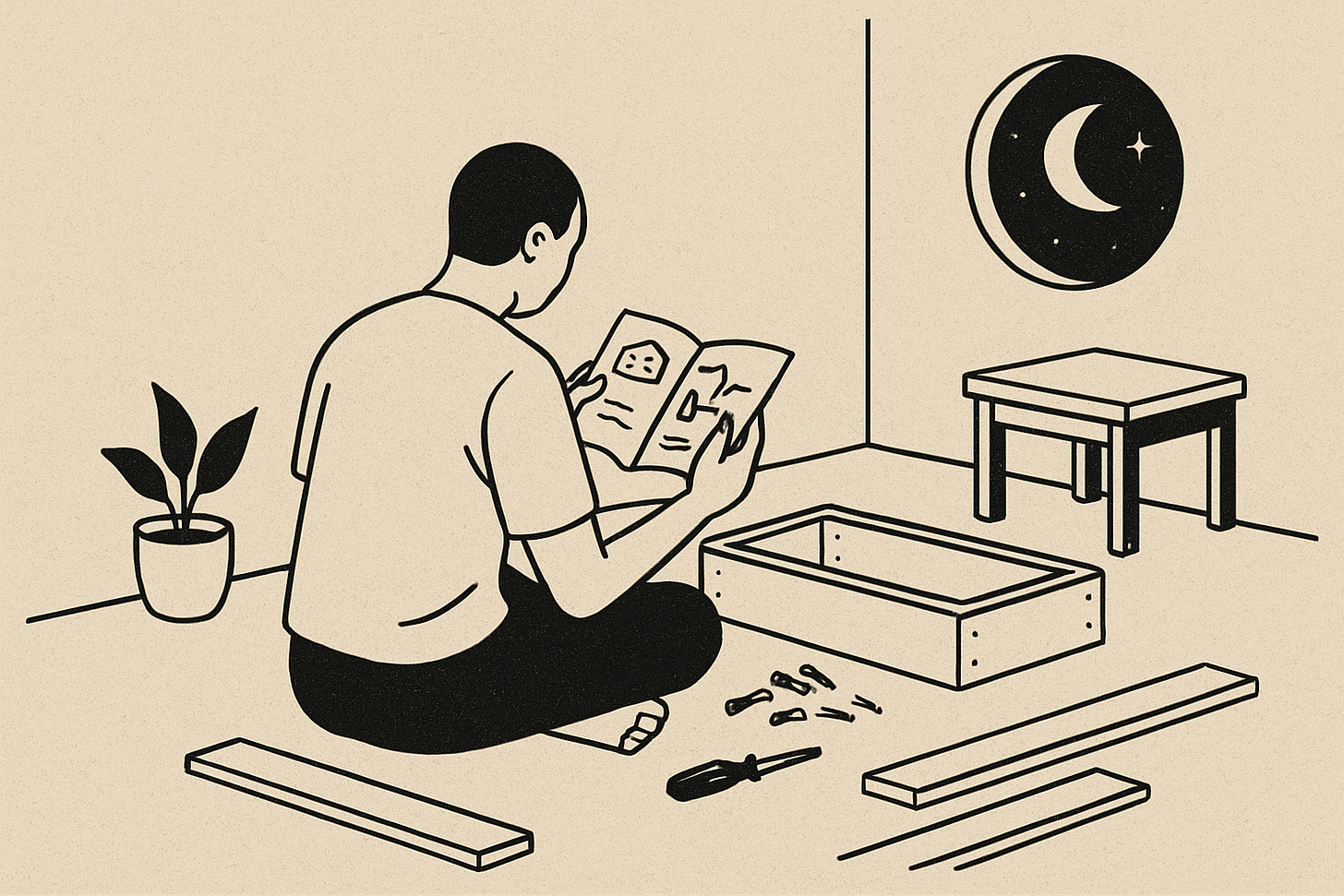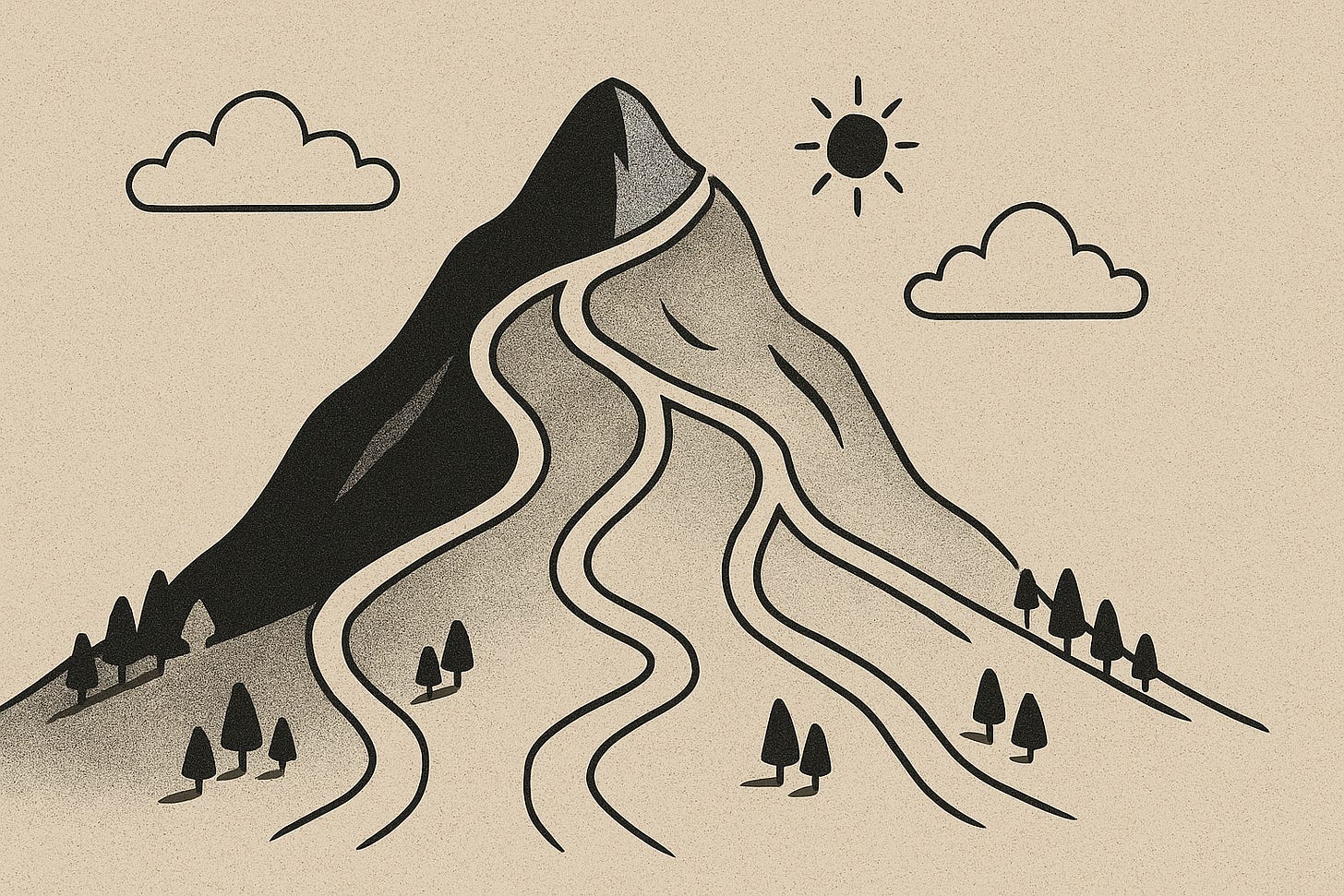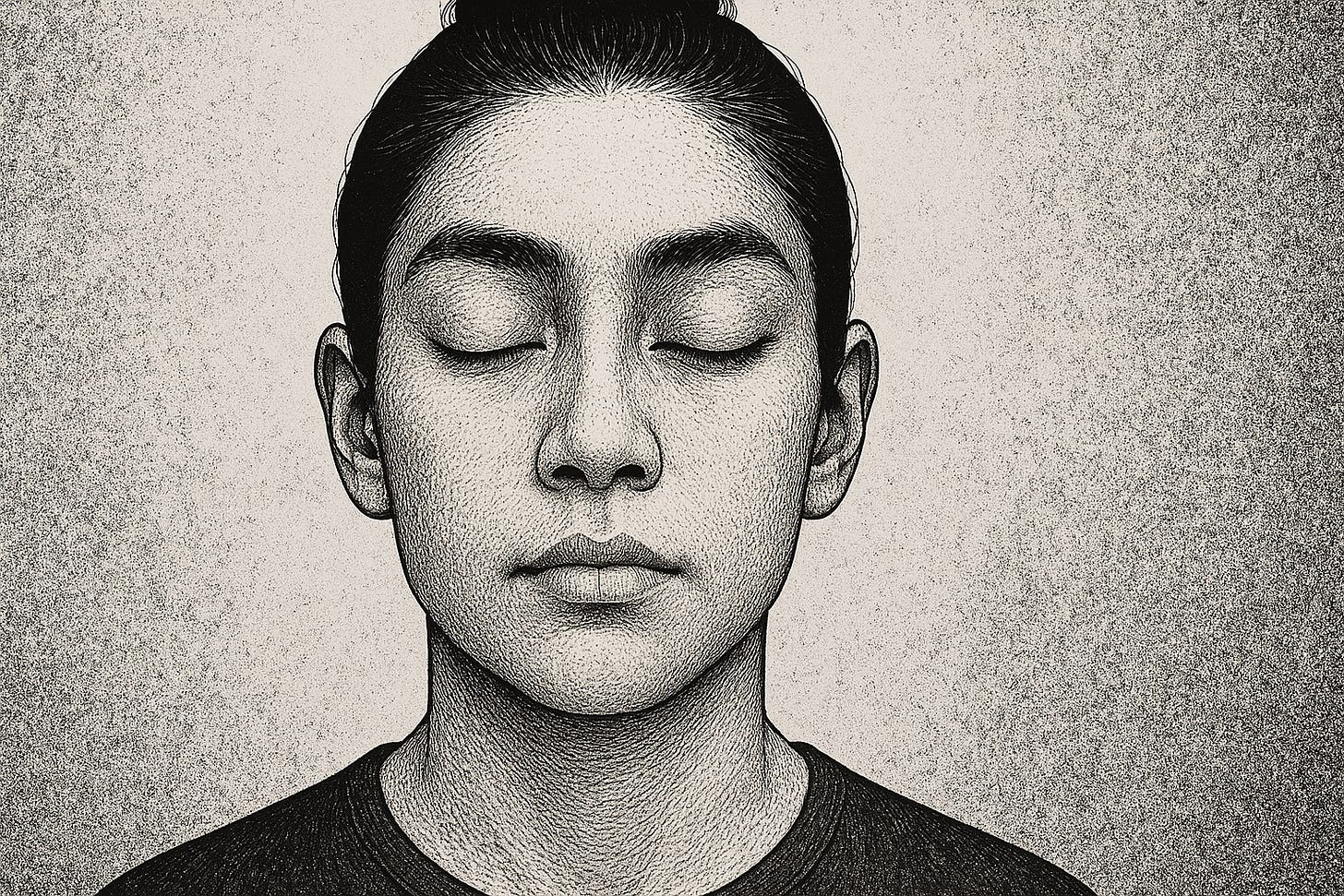So far, I’ve been enjoying the one sutra at a time format for this newsletter.
They aren’t necessarily written with the intent of being read just one at a time, but doing so feels (to me at least) like it gives time to really dig deeper on the way some of these rather dense ideas can be examined in the context of modern life.
I think that, generally, moving slowly through the text helps it to feel more like studying a map than reading an instruction manual.
— when you look at a map, you’re just trying to get an overall sense of where you’re heading by noting certain landmarks or potential obstacles, and you know intuitively that you’re the one that needs to walk the path.
— when you read instructions, it’s much easier to slip into externalization, and you can end up spending more time worrying if you got it right “by the book” vs. building something that’s functional in your space/time now.
If that doesn’t make sense right away, think about the last time you put together Ikea furniture.
Maybe you’re the kind of person that just looks at the picture on the box and starts screwing things together. Kudos for being a motivated self-starter! But you’ll probably have to take a few things apart along the way. Totally fine if you expect some detours and are focused on learning from the process.
Maybe you’re (like me) the kind of person that separates all the pieces into different piles so you can see the numbers before you even look at the instructions. Kudos for being organized! But haven’t even those people run into times when the instructions weren’t quite right? The little drawings of the screws aren’t always to scale, and the technical writers (the people who write the instructions) do make mistakes.
They can give you all the tools you need and extra pieces of each part, but they can’t account for the weird slope in your floor or the custom baseboard on your wall that mean you need to leave some of the trim off that $100 dresser in order for it to fit in your house.
Anyways, the bottom line is that language is a limited form of conveying ideas.
It’s impossible to account for all the variables that influence the ultimate interpretation of a given idea. Speaking is truly like blowing seeds off a dandelion — despite even the best of conditions, you really have no idea where those seeds are going to land.
So I feel it’s valuable to approach language less literally.
Yah, I know that sounds like a paradox, but I don’t think it’s a stretch to state that we’ve collectively put a lot more weight onto the verbatim interpretation of text as a primary means for navigating the world than we should.
Stay with me on this —
All I really mean to say is that language can be seen as a map towards the ideas held in a human mind, which are themselves merely interpretations of some layer of the underlying energies circulating in the substrate of reality.
We live in a state of uncertainty all the time, whether we recognize/admit it or not. Our brains appear to be wired towards dispelling uncertainty, and we tend to fill gaps in comprehension with assumptions rather than hold them as they are (unclear & not fully understood).
Reading something as an instruction manual assumes exhaustive coverage and weakens agency. Reading something as a map assumes only the overview, and relies on agency for real-time navigation.
With that metaphor constructed, this week I’m going to bundle the next 5 sutras side-by-side since I think these 5 rely on each other for interpretation, more so than the others. Arguably, they all do — but taken alone, this set feels too short.
Think of them like 5 quick switchbacks on a steep trail. Each portion of the trail is, on it’s own, brief and doesn’t have much room for wandering. But together they string together a steep ascent.
You can also look at them as 5 different paths to the same peak. One truth, many paths — right?
Ok! Enough metaphors for today (maybe). Let’s get into it:
****भवप्रत्ययो विदेहप्रकृतिलयानाम् — bhavapratyayo videhaprakṛtilayānām Translation: For those who have been disembodied (videha) or merged into primal nature (prakṛtilaya), samādhi (absorption) arises as a natural process.
श्रद्धावीर्यस्मृतिसमाधिप्रज्ञापूर्वक इतरेषाम् — śraddhā-vīrya-smṛti-samādhi-prajñā-pūrvaka itareṣām
Translation:
For others, samādhi is preceded by faith (śraddhā), vigor (vīrya), memory (smṛti), concentration (samādhi), and higher wisdom (prajñā).
तीव्रसंवेगानामासन्न — tīvra-saṁvegānām āsannaḥ
Translation:
For those who have intense zeal and determination, realization is very near.
मृदुमध्याधिमात्रत्वात्ततोऽपि विशेष — mṛdu-madhyādhimātratvāt tato’pi viśeṣaḥ
Translation:
Even among those who strive, differences arise according to whether their practice is mild, moderate, or intense.
ईश्वरप्रणिधानाद्वा — īśvara-praṇidhānād vā
Translation:
Or (samādhi is attained) through devotion and surrender to Īśvara (the Supreme Being).
Pulling out just English is helpful:
For those who have been disembodied (videha) or merged into primal nature (prakṛtilaya), samādhi (absorption) arises as a natural process. For others, samādhi is preceded by faith (śraddhā), vigor (vīrya), memory (smṛti), concentration (samādhi), and higher wisdom (prajñā). For those who have intense zeal and determination, realization is very near. Even among those who strive, differences arise according to whether their practice is mild, moderate, or intense. Or (samādhi is attained) through devotion and surrender to Īśvara (the Supreme Being).
Now, in the version I’m reading, Sri Swami Satchidananda clarifies that videha refers to the concept of a living being that achieves a level of total absorption during a certain lifetime (but not full liberation) which allows them to transcend their body. Videha literally means “without body”.
Personally, I remain agnostic to the idea of reincarnation. A broad reading of the law of conservation of mass (matter cannot be created or destroyed in an isolated system; it can only change forms) does leave room for reincarnation to be taken somewhat seriously, even if just in a boring modern scientific sense.
A friend once quipped to me on this subject: “I’m not interested in whether or not my atoms exist forever, I want to know if I will continue to exist after I die.”
There are plenty of scriptural texts that claim to have the answer to that question, and they get very detailed into the whitherto’s and wherefore’s around what has to be cosmic equivalent of a logistical nightmare. Let’s just hope that if it is the case (that we are reincarnated over lifetimes) that the guy running the delivery network is the videha version of Jeff Bezos.
Jokes aside — and I don’t really care if you think reincarnation is total crack or super obvious — either way, there’s a very practical allusion being made in this set of 5 sutras that shouldn’t be missed.
Remember that we are approaching the idea of samadhi, understood as complete and total absorption with [blank] << insert your preferred concept for the is-ness here (the divine, base reality, God, whatever works for you).
The last two sutras dealt with the idea that there are gradations for this approach, meaning that samadhi is not always an absolute value. It can be achieved gradually through cultivating pure presence first with the things that are most near and obvious (the physical) then taking that presence wider and wider through subtler and subtler aspects of experience.
But there are also several different “angles of attack” for this work. I’ll rewrite the translations briefly here to illustrate…
When thinking about samadhi, there are a few ways to occasion that state:
You can transcend your physical body.
You can (still being a body) achieve it through practices like faith, vigor, concentration, and wisdom.
If you try really hard at any of those, it might not take too long at all.
Even if you’re trying really hard, the intensity of your practice will determine the outcome.
Or you can just completely surrender to the Supreme Being.
I don’t know about you, but to me, 19 and 23 look like two extreme ends of a spectrum with the graspable ideas sandwiched between them.
What exactly would “transcending your body” entail? And how do you just “surrender” to a “Supreme Being”?
If those seem out of reach, grab whichever practice is most agreeable to you, and give it all you’ve got.
faith
vigor
concentration
wisdom
The key line is, for me, right in the middle (of course). If you try really hard at any of those, it might not take too long at all.
My simple suggestion today is to ponder whether or not that’s the whole gambit of samadhi, right there.
Whichever path you’re on, whichever practice you find yourself doing — give it absolutely everything you’ve got. Don’t hold back.
Isn’t that the long and short of samadhi? It’s TOTAL absorption. Not just the parts of you you’re prepared to give away, or the times you feel like it. ALL of you, ALL the time.
Perhaps it’s simply fear of loss that holds us back from this…
But what are we holding onto anyways? Can we bring any of it with us at the end of our days?
You can’t fill a cup that’s already full. So in the simplest sense, we can practice pouring out all we’ve got, over and over. When we get stronger and we can maintain the space that creates in our experience, let’s see what comes in to fill that space.
Whichever path you find yourself on, lean into it. And that doesn’t mean “rush”. It means feel every damn step along the way. Devote yourself to the experience. Call your attention back in to the task at hand instead of worrying about the end goal or whether you did the last movement with perfect form.
Now is always the time.
Now begins yoga.








